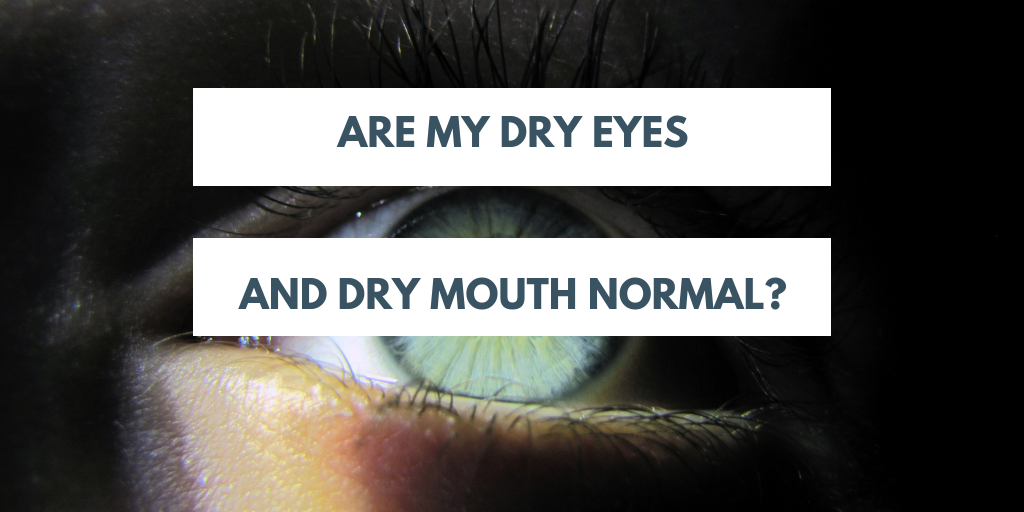Are my dry eyes and dry mouth normal?
Guest Post by Michelle Darnell, OD
It is well-documented that as a person ages, the mucous membranes of the body, including the eyes and mouth, become drier. In fact, in my practice, the most common concern for women over the age of fifty is eyes that itch, burn, or water constantly. Many of those patients have discussed their symptoms with friends or family members, and as such, believe this discomfort is something they have to live with.
But what if it is not normal? Sjogren’s (SHOW-grins) Syndrome is an autoimmune condition where the body’s immune system attacks the tissues that produce fluid, most noticeably the tear and saliva glands. Sjogren’s is, in fact, primarily identified by its two most common symptoms: dry eyes, and dry mouth. Damage is not just limited to the eyes and mouth, however. In addition, it can attack our joints, thyroid gland, kidneys, liver, lungs, skin, nerves, and other mucous membranes, such as the vagina.
Sjogren’s is the third most common autoimmune condition, behind Rheumatoid Arthritis (RA) and Systemic Lupus Erythematosus (SLE). Approximately 50% of all Sjogren’s cases are “primary,” or existing without a co-occurring autoimmune condition, while the other 50% of Sjogren’s cases occur as a complication from an original auto-immune condition.
There are several risk factors for Sjogren’s. As mentioned above, a pre-existing autoimmune condition, specifically in the Rheumatic category (RA or SLE), puts a person at an increased risk for developing Sjogren’s. Being female also carries a higher risk, with 9/10 of all Sjogren’s patients being female. Collecting birthdays is the final major risk factor, with most cases not being diagnosed until the patient is over the age of 40. That being said, the worst case of Sjogren’s-related dry eye that I have ever seen personally was in a 17 year old girl.
How do you know if your dry eyes and mouth are due to aging, or due to Sjogren’s? Diagnosis can be difficult, because the symptoms of Sjogren’s, especially in mild or moderate cases, can mirror many other common conditions, and are often considered a normal part of aging by patients. Other medications, such as antihistamines (anti-allergy medications), can cause the mucous membranes of the body to dry out, as well. The good news is that there are many blood tests available to look for markers indicative of Sjogren’s Syndrome. Your eye care provider may be able to perform a Sjo test, which involves a finger prick for blood, akin to the finger prick to check blood glucose, which is sent to an outside lab for evaluation. Your provider can also order a panel of bloodwork to look for anti-nuclear antibodies (ANA), anti-SSA and anti-SSB antibodies, and rheumatoid factor.
If you are diagnosed with Sjogren’s, it is recommended that you discuss treatment options with your provider, or with a rheumatologist. You may be placed on metformin, Plaquenil (Concordia Pharmaceuticals), or a DMARD-class medication to help control your body’s immune response. Discussing your diet and lifestyle with a provider who is specially trained in autoimmune conditions will be very helpful in mediating inflammation, as well.
In addition, your eye doctor can initiate a dry eye regimen tailored specifically to you, and to your symptoms. Artificial tears are often the first step, though it is important to know that artificial tears are not intended to provide long-term relief, merely to help temporarily reduce acute symptoms. For those patients who use artificial tears more than four times per day, please invest in preservative-free artificial tears, as the preservatives in standard artificial tears, when constantly applied to the eye, can cause more harm than good over the long term.
For those for whom the artificial tears do not “cut it,” other alternatives are available. Ointment that has the consistency of Vaseline can be used, usually at night, to prevent the eyes from becoming dry and “chapped” overnight, or during a bad attack of dryness. Specially-designed contact lenses that are large enough to cover the entire surface of the eye, called scleral lenses, are routinely used in severe cases of dry eye, as these lenses hold moisture against the eye all day long. Medications, such as Restasis or Xiidra, can also reduce inflammation on the surface of the eye and promote healthy tear production. In patients who have severe “attacks” of dry eye, we can even use contact lenses that are made out of amniotic membranes, which include stem cells and other natural healing properties that help repair the front of the eye. I have a patient who comes in every six months like clockwork, to get amniotic membrane contacts placed on her eyes to repair the chapping caused by her dry eye, which vastly improves her ocular comfort, as well as the clarity of her vision.
It is important to note that, even if you do not have Sjogren’s, if your eyes are uncomfortable, or you find yourself noticing watery, itchy, or burning eyes, have your eyes evaluated by your eye care provider. Your eye doctor can develop a treatment plan that will make your eyes more comfortable.
Michelle Darnell, OD is an optometrist who owns Lilac Family Eye Care in Liberty Lake. She actively treats dry eye, and routinely co-manages medical conditions, such as Sjogren’s Syndrome and other auto-immune diseases, by coordinating treatments with a patient’s complete healthcare team.

